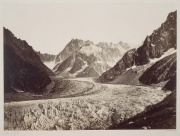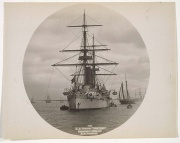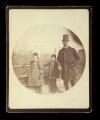Albumen paper
Description
A photographic Printing out paper widely used from about 1850-1890. Albumen paper was invented by Louis Desiré Blanquart and presented to the French Academy of Sciences in 1850. Blanquart used a thin layer of egg white protein to disperse and bind photosensitive salts. Egg white was whipped then allowed to settle to a liquid; this formed a homogeneous liquid which was mixed with small amounts of salt (usually Sodium chloride or Ammonium chloride) and Citric acid, then spread as a thin layer over a high quality cellulosic paper. After drying, the layer was activated by treatment with Silver nitrate to form Silver chloride, a light sensitive compound. To create an image, a negative was placed in direct contact with the paper, then exposed to daylight. Once the development was complete, it was stopped by treating the paper with a fixing agent such as Sodium thiosulfate. Albumen prints were a golden to purplish brown color with a glossy surface. It was replaced in the 1890s by Silver gelatin paper.
Synonyms and Related Terms
albumen prints; silver albumen photograph
Additional Information
Timothy Vitale, Paul Messier, "Physical and Mechanical Properties of Albumen Photographs" JAIC 33(3):279-99, 1994.
Comparisons
Additional Images
Authority
- E.J.LaBarre, Dictionary and Encyclopedia of Paper and Paper-making, Swets & Zeitlinger, Amsterdam, 1969 Comment: dates of use = 1850-1890
- The Dictionary of Art, Grove's Dictionaries Inc., New York, 1996 Comment: final date of use = 1895
- Luis Nadeau, Encyclopedia of Printing, Photographic, and Photomechanical Processes, Atelier, New Brunswick, 1997 Comment: Invented by Louis Desire Blanquart in the late 1840s and presented to the French Academy of Sciences on May 27, 1850.
- Caring for your Collections, Arthur W Schulz (ed.), Harry N. Abrams, Inc. , New York, 1992 Comment: Debbie Hess Norris chapter; dates of use = 1855-1885
- Website address 1 Comment: Preservation 101 Glossary of Terms -invented in 1850 by Louis-Desire Blanquart-Evrard










